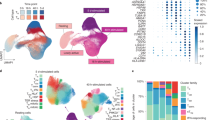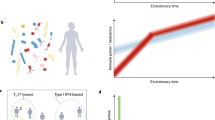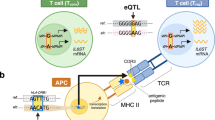Abstract
The adaptive immune system in mammals acts in a coordinated manner to eliminate environmentally derived pathogens. Humans, mice and rats show within species variation in the levels and ratios of their peripheral CD4+ and CD8+ T cells and to a significant degree this variation is under the control of polymorphic genes. Whether genes act separately to specify CD4+ and CD8+ subpopulation levels or whether CD8+ variation is controlled through gene and environmental action on CD4+ cells or vice versa, is not known. We use a quantitative modelling approach in identical and non-identical female human twins to delineate the lines of control which act upon and between CD4+ and CD8+ subsets. The major findings of the study are: (1) genetic variation controls CD8+ T cell levels through two major routes—the first is via an effect on CD4+ T cells which accounts for the observed co-variation between CD4+ and CD8+ T cells, the second is through direct action on CD8+ T cell levels. (2) No evidence of a gene effect from CD8+ T cells on CD4+ cells is observed. Our findings have implications for the evolution of the complex defence system of which CD4+ and CD8+ T cells are a crucial part and encourage further work towards locating common pleiotropic quantitative trait loci responsible for variation in numbers of T cells.
This is a preview of subscription content, access via your institution
Access options
Subscribe to this journal
Receive 6 digital issues and online access to articles
$119.00 per year
only $19.83 per issue
Buy this article
- Purchase on Springer Link
- Instant access to full article PDF
Prices may be subject to local taxes which are calculated during checkout
Similar content being viewed by others
References
Janeway CA, Travers P Immunobiology. The Immune System in Health and Disease. 2nd edn Churchill Livingston: London 1996
Mitchison, A Will we survive Sci Am 1993 269 136–144
Zinkernagel RM, Doherty PC MHC-restricted cytotoxic T cells: studies on the biological role of polymorphic major transplantation antigens determining T-cell restriction-specificity, function, and responsiveness Adv Immunol 1979 27 51–177
Townsend AR, Rothbard J, Gotch FM, Bahadur G, Wraith D, McMichael AJ The epitopes of influenza nucleoprotein recognized by cytotoxic T lymphocytes can be defined with short synthetic peptides Cell 1986 44 959–968
Amadori A, Zamarchi R, De Silvestro G et al Genetic control of the CD4/CD8 T-cell ratio in humans Nat Med 1995 1 1279–1283
Clementi M, Forabosco P, Amadori A et al CD4 and CD8 T lymphocyte inheritance. Evidence for major autosomal recessive genes Hum Genet 1999 105 337–342
Damoiseaux JG, Cautain B, Bernard I et al A dominant role for the thymus and MHC genes in determining the peripheral CD4/CD8 T cell ratio in the rat J Immunol 1999 163 2983–2989
Kraal G, Weissman IL, Butcher EC Genetic control of T-cell subset representation in inbred mice Immunogenetics 1983 18 585–592
Jaeger EEM, Bontrop RE, Parham P, Wickings EJ, Kadwell M, Lanchbury JS Characterisation of chimpanzee TCRV gene polymorphism: how old are human TCRV alleles? Immunogenetics 1998 47 115–123
Bontrop RE, Otting N, Slierendregt BL, Lanchbury JS Evolution of major histocompatibility complex polymorphisms and T cell receptor diversity in primates Immunolog Rev 1995 143 33–62
Kunkel HG, Yount WJ, Litwin SD Genetically determined antigen of the Ne subgroup of gamma-globulin: detection by precipitin analysis Science 1966 154 1041–1043
Torkar M, Norgate Z, Colonna M, Trowsdale J, Wilson MJ Isotypic variation of novel immunoglobulin-like transcript/killer cell inhibitory receptor loci in the leukocyte receptor complex Eur J Immunol 1998 28 3959–3967
Evans DM, Frazer IH, Martin NG Genetic and environmental causes of variation in basal levels of blood cells Twin Res 1999 2 250–257
Hall MA, Ahmadi KA, Norman P et al Genetic influence on peripheral blood T lymphocyte levels Genes Immun 2000 1 423–427
Loehlin JC The Cholesky Approach: a cautionary note Behav Genet 1996 26 65–69
Heath AC, Kessler RC, Neale MC, Hewitt JK, Eaves LJ, Kendler KS Testing hypotheses about direction of causation using cross-sectional family data Behav Genet 1993 23 29–50
Neale MC, Cardon LR Methodologies for Genetic Studies of Twins and Families Kluwer Academic Publishers: Dordrecht 1992
Duffy DL, Martin NG Inferring the direction of causation in cross-sectional twin data: theoretical and empirical considerations Genet Epidemiol 1994 11 483–502
Neal MC, Walters E, Heath AC et al Depression and parental bonding: cause, consequence, or genetic covariance? Genet Epidemiol 1994 11 503–522
Ramos-Arroyo MA, Ulbright TM, Yu PL, Christian JC Twin study: relationship between birth weight, zygosity, placentation, and pathologic placental changes Acta Genet Med Gemellol 1988 37 229–238
Mehr R, Perelson AS, Fridkis-Hareli M, Globerson A Regulatory feedback pathways in the thymus Immunol Today 1997 18 581–585
Amadori A, Zamarchi R, Chieco-Bianchi L CD4: CD8 ratio and HIV infection: the “tap-and-drain” hypothesis Immunol Today 1996 17 414–417
Almasy L, Dyer TD, Blangero J Bivariate quantitative trait linkage analysis: pleiotropy versus co-incident linkages Genetic Epidemiol 1997 14 953–958
Eaves LJ, Neale MC, Maes H Multivariate multipoint linkage analysis of quantitative trait loci Behav Genet 1996 26 519–525
Fulker DW, Cherny SS An improved multipoint sib-pair analysis of quantitative traits Behav Genet 1996 26 527–532
Fulker DW, Cherny SS, Sham PC, Hewitt JK Combined linkage and association sib-pair analysis for quantitative traits Am J Hum Genet 1999 64 259–267
Todorov AA, Vogler GP, Gu C et al Testing causal hypotheses in multivariate linkage analysis of quantitative traits: general formulation and application to sibpair data Genet Epidemiol 1998 15 263–278
Almasy L, Williams JT, Dyer TD, Blangero J Quantitative trait locus detection using combined linkage/disequilibrium analysis Genet Epidemiol 1999 17 (Suppl 1) S31–S36
Blangero J, Williams JT, Almasy L Quantitative trait locus mapping using human pedigrees Hum Biol 2000 72 35–62
Boomsma DI Using multivariate genetic modeling to detect pleiotropic quantitative trait loci Behav Genet 1996 26 161–166
Kruglyak L, Lander ES Complete multipoint sib-pair analysis of qualitative and quantitative traits Am J Hum Genet 1995 57 439–454
Kruglyak L, Lander ES A nonparametric approach for mapping quantitative trait loci Genetics 1995 139 1421–1428
Spector TD, Snieder H, MacGregor AJ Advances in Twin and Sib-pair Analysis Greenwich Medical Media: London 1999
Goldsmith HH A zygosity questionnaire for young twins: a research note Behav Genet 1991 21 257–269
Kyvik KO Generalisability and assumptions of twin studies. In: Spector TD, Snieder H, MacGregor AJ (eds) Advances in Twin and Sib-Pair Analysis Greenwich Medical Media: London 1999 pp 67–77
Acknowledgements
MAH is an Arthritis Research Campaign Postdoctoral Research Fellow. Avrion Mitchison is gratefully acknowledged for his comments on the manuscript.
Author information
Authors and Affiliations
Corresponding author
Additional information
We are grateful to the Special Trustees of St Thomas’ Hospital and Gemini Genomics Limited for support in initiating this research. The Twin Research Unit also receives support from the Arthritis Research Campaign, the Wellcome Trust and the Chronic Disease Research Foundation.
Rights and permissions
About this article
Cite this article
Ahmadi, K., Hall, M., Norman, P. et al. Genetic determinism in the relationship between human CD4 + and CD8 + T lymphocyte populations?. Genes Immun 2, 381–387 (2001). https://doi.org/10.1038/sj.gene.6363796
Received:
Revised:
Accepted:
Published:
Issue Date:
DOI: https://doi.org/10.1038/sj.gene.6363796
Keywords
This article is cited by
-
Innate and adaptive immune traits are differentially affected by genetic and environmental factors
Nature Communications (2017)
-
Mapping quantitative trait loci for T lymphocyte subpopulations in peripheral blood in swine
BMC Genetics (2011)
-
Impact of MHC class II polymorphism on blood counts of CD4+ T lymphocytes in macaque
Immunogenetics (2011)
-
Total blood lymphocyte counts in hemochromatosis probands with HFEC282Y homozygosity: relationship to severity of iron overload and HLA-A and -B alleles and haplotypes
BMC Hematology (2005)
-
Novel association suggests multiple independent QTLs within chromosome 5q21–33 region control variation in total humans IgE levels
Genes & Immunity (2003)



